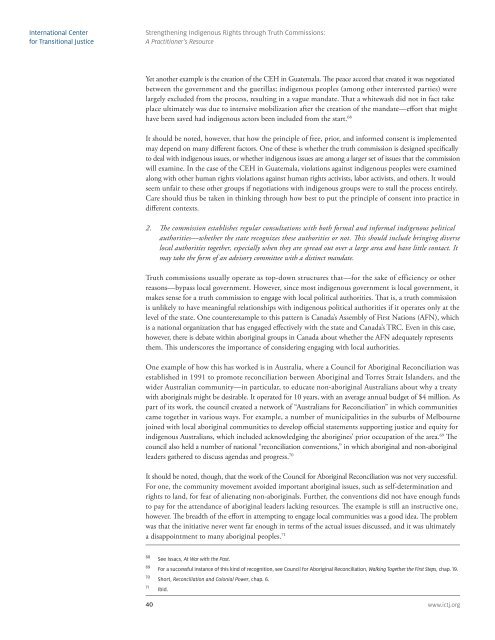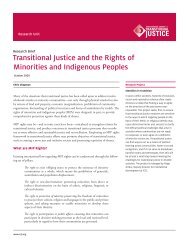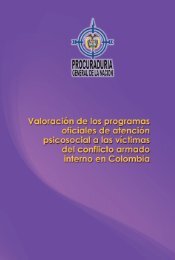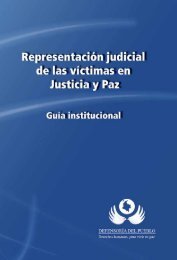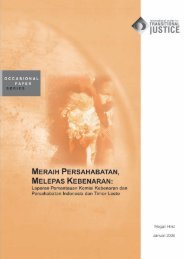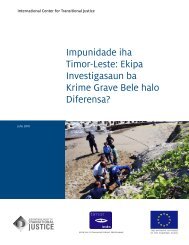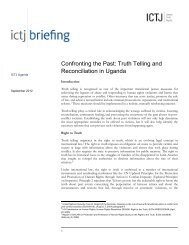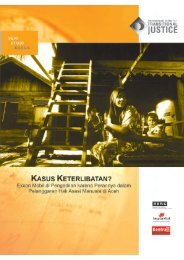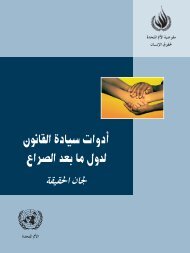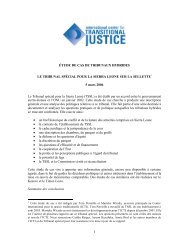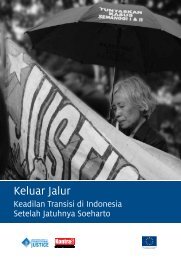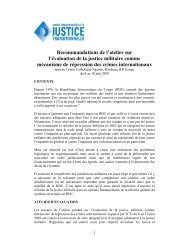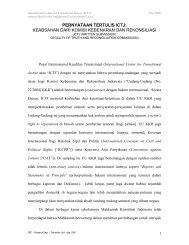Strengthening Indigenous Rights through Truth Commissions: A ...
Strengthening Indigenous Rights through Truth Commissions: A ...
Strengthening Indigenous Rights through Truth Commissions: A ...
- No tags were found...
You also want an ePaper? Increase the reach of your titles
YUMPU automatically turns print PDFs into web optimized ePapers that Google loves.
International Centerfor Transitional Justice<strong>Strengthening</strong> <strong>Indigenous</strong> <strong>Rights</strong> <strong>through</strong> <strong>Truth</strong> <strong>Commissions</strong>:A Practitioner’s ResourceYet another example is the creation of the CEH in Guatemala. The peace accord that created it was negotiatedbetween the government and the guerillas; indigenous peoples (among other interested parties) werelargely excluded from the process, resulting in a vague mandate. That a whitewash did not in fact takeplace ultimately was due to intensive mobilization after the creation of the mandate—effort that mighthave been saved had indigenous actors been included from the start. 68It should be noted, however, that how the principle of free, prior, and informed consent is implementedmay depend on many different factors. One of these is whether the truth commission is designed specificallyto deal with indigenous issues, or whether indigenous issues are among a larger set of issues that the commissionwill examine. In the case of the CEH in Guatemala, violations against indigenous peoples were examinedalong with other human rights violations against human rights activists, labor activists, and others. It wouldseem unfair to these other groups if negotiations with indigenous groups were to stall the process entirely.Care should thus be taken in thinking <strong>through</strong> how best to put the principle of consent into practice indifferent contexts.2. The commission establishes regular consultations with both formal and informal indigenous politicalauthorities—whether the state recognizes these authorities or not. This should include bringing diverselocal authorities together, especially when they are spread out over a large area and have little contact. Itmay take the form of an advisory committee with a distinct mandate.<strong>Truth</strong> commissions usually operate as top-down structures that—for the sake of efficiency or otherreasons—bypass local government. However, since most indigenous government is local government, itmakes sense for a truth commission to engage with local political authorities. That is, a truth commissionis unlikely to have meaningful relationships with indigenous political authorities if it operates only at thelevel of the state. One counterexample to this pattern is Canada’s Assembly of First Nations (AFN), whichis a national organization that has engaged effectively with the state and Canada’s TRC. Even in this case,however, there is debate within aboriginal groups in Canada about whether the AFN adequately representsthem. This underscores the importance of considering engaging with local authorities.One example of how this has worked is in Australia, where a Council for Aboriginal Reconciliation wasestablished in 1991 to promote reconciliation between Aboriginal and Torres Strait Islanders, and thewider Australian community—in particular, to educate non-aboriginal Australians about why a treatywith aboriginals might be desirable. It operated for 10 years, with an average annual budget of $4 million. Aspart of its work, the council created a network of “Australians for Reconciliation” in which communitiescame together in various ways. For example, a number of municipalities in the suburbs of Melbournejoined with local aboriginal communities to develop official statements supporting justice and equity forindigenous Australians, which included acknowledging the aborigines’ prior occupation of the area. 69 Thecouncil also held a number of national “reconciliation conventions,” in which aboriginal and non-aboriginalleaders gathered to discuss agendas and progress. 70It should be noted, though, that the work of the Council for Aboriginal Reconciliation was not very successful.For one, the community movement avoided important aboriginal issues, such as self-determination andrights to land, for fear of alienating non-aboriginals. Further, the conventions did not have enough fundsto pay for the attendance of aboriginal leaders lacking resources. The example is still an instructive one,however. The breadth of the effort in attempting to engage local communities was a good idea. The problemwas that the initiative never went far enough in terms of the actual issues discussed, and it was ultimatelya disappointment to many aboriginal peoples. 716869707140See Issacs, At War with the Past.For a successful instance of this kind of recognition, see Council for Aboriginal Reconciliation, Walking Together the First Steps, chap. 19.Short, Reconciliation and Colonial Power, chap. 6.Ibid.www.ictj.org


